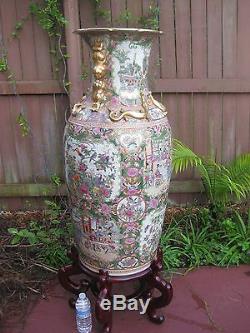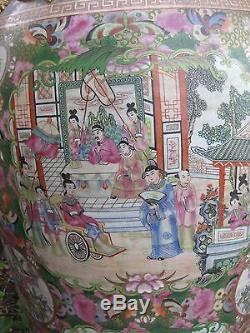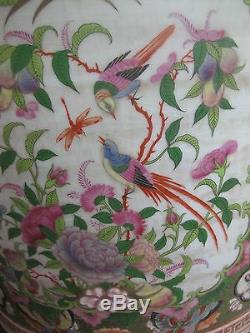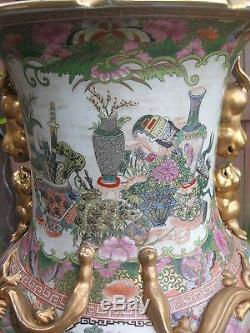CHINESE ROSE MEDALLION PORCELAIN GILT FLOOR VASE, 95cm, Late Qing Dynasty














CHINESE ROSE MEDALLION PORCELAIN GILT FLOOR VASE, 95cm, Late Qing Dynasty. 38 inches = 95cm tall, the wood stands adds 12 inches = 30 cm. Condition report: The vase is in perfect condition.
There are no cracks, no chips, there is a minimum loss of the gilt on some prominent parts, especially on the upper rim. PORCELAIN GILT CHINESE ROSE MEDALLION FLOOR VASE.
In the mid-19th century, the Chinese developed a pattern of china that became ravenously popular in Europe and the United States. While this pattern, called Rose Medallion, has waned somewhat in popularity in the past 15 years, it is still a beautiful example of the category called Chinese export. Starting in the 17th century, European demand for porcelain (china) from China was so strong that large quantities were made exclusively for export. The exports originally were mostly to Europe, but eventually the United States was a major customer.
This "Chinese export" is quite collectible. When decorating with Oriental objects was popular in the 1970s and 1980s, Chinese export became very expensive. Since the 1990s, it has cooled off and prices have dropped, but the collectability is still there.
In the mid-1800s one of the patterns developed for export was Rose Medallion. It was a hit in Europe and production increased.
Enough Rose Medallion was made so that, even today, it is not really difficult to find, but larger and more unusual pieces can still be considered somewhat scarce. The appearance of Rose Medallion china is quite distinctive.
In the center is a medallion that contains either a peony or a bird. Radiating out from the medallion are panels, usually four or six. The panels have a background of peonies or leaves and in the foreground are birds and possibly people. Greens and pinks are the dominant colors, so much so that Rose Medallion pieces can often be spotted across a room. If a piece of porcelain looks like Rose Medallion but has no people or birds present, it is called Rose Canton. If no birds are present, only people, it is called Rose Mandarin.Naturally, the earliest pieces of Rose Medallion are the toughest to find and the most valuable. Older pieces often have a gold rim, no mark on the bottom, pitting in the porcelain, and they frequently have the scratches associated with actual use. While the earlier pieces are more likely to have pitting, the artistic and decorative appearance of the old pieces are generally superior to later examples.
In 1890, the McKinley Tariff Act was passed by the U. Part of the law required that all imported items have marks for nation of origin.
Therefore, after 1890, the word "China" was put on the bottom of Rose Medallion items. Around 1915 this was changed to made in China. Some less than honest people have tried to remove these marks to make a piece of porcelain appear older than it really is.
It is good to examine Rose Medallion pieces to be sure there is no scar from such a removal. Rose Medallion is still being made, but modern pieces are much less valuable. If the bottom of a piece says "made in Hong Kong" or if it has Chinese lettering, it is most likely too modern to be of interest to the collector. Most of the standard items one finds in a china set can be found in the Rose Medallion pattern. Plates, saucers, cups, chargers, platters, tureens, pitchers, and much more.
In terms of value, a good rule is that the larger the piece the better. When examining Rose Medallion, always look for cracks and repairs, as they are common and quite detrimental to value. The item "CHINESE ROSE MEDALLION PORCELAIN GILT FLOOR VASE, 95cm, Late Qing Dynasty" is in sale since Wednesday, July 6, 2016. This item is in the category "Antiques\Asian Antiques\China\Vases". The seller is "ukr10" and is located in Clearwater Beach, Florida.
This item can be shipped to United States.- Age: 1850-1899
- Original/Reproduction: Original
- Type: Vases
- Region of Origin: China
- Color: Multicolored
- Primary Material: Porcelain & Pottery
- Maker: Rose Medallion


